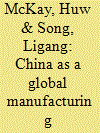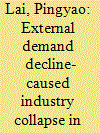| Srl | Item |
| 1 |
ID:
096221


|
|
|
|
|
| Publication |
2010.
|
| Summary/Abstract |
This study examines the nature and consequences of China's rise to the center of world economic affairs through manufacturing-led development. Our historical analysis shows that China is still well short of the point in its developmental process where its growth might be reasonably expected to slow, or the energy, resource and carbon intensity of growth to recede. The study argues that the current trajectory of industrialization will have to be altered when China becomes more actively engaged in dealing with structural issues at home and abroad against the background of the unwinding of global imbalances. One profitable strategy that China might employ would be to approximate the incredibly fruitful mass-market integration efforts of the USA that eventually elevated it to its position of global primacy. The cyclical re-emergence of excess capacity in Chinese heavy industry, serious questions about the medium term ability of other major regions to accommodate further large gains in Chinese market share, and the stark conflict between the contemporary style of industrial development and the health of the biosphere indicate strongly that now is the time to catalyze the required adjustment and reform processes that will underpin sustainable long-run prosperity.
|
|
|
|
|
|
|
|
|
|
|
|
|
|
|
|
| 2 |
ID:
096222


|
|
|
|
|
| Publication |
2010.
|
| Summary/Abstract |
Using an input-output method, this paper simulates the impacts of the global financial crisis and the decline of exports on China's economy and employment. With shrinking external demand, boosting domestic demand becomes crucial for maintaining economic growth and promoting employment. Our simulated results indicate that an investment scenario with employment as a priority can achieve the objective of employment maximization without significantly reducing growth. Public investment should focus on employment, education, health, housing and social security to rebalance China's economy so that it can realize sustained and stable economic growth.
|
|
|
|
|
|
|
|
|
|
|
|
|
|
|
|
| 3 |
ID:
096223


|
|
|
|
|
| Publication |
2010.
|
| Summary/Abstract |
Industry collapse has become an important phenomenon in China's recent economic growth fluctuation. This paper develops a simple model to analyze this phenomenon. Our analysis focuses on an external demand decline-caused industry collapse. The model reveals that the combination of large-scale decline in external demand with a horizontal domestic supply curve causes the domestic export industry to undergo a sharp decrease in output in a short period of time, which further leads to a sharp decline in employment. The conventional stabilization policy is less effective in coping with this sudden industry collapse. The Chinese Government needs to formulate an appropriate structural industry stabilization policy to cope with the sudden industry collapse, and, in particular, to implement a direct employment aid program to deal with unemployment resulting from the industry collapse.
|
|
|
|
|
|
|
|
|
|
|
|
|
|
|
|
| 4 |
ID:
096226


|
|
|
|
|
| Publication |
2010.
|
| Summary/Abstract |
Using a survey administered in Zhongguancun Science Park in Beijing, China, this paper investigates the impact of R&D personnel-related intellectual property management practices on the patent propensity of small technology-based firms. It is found that R&D personnel-related management practices, including training and reward mechanisms, are effective in enhancing a firm's willingness to patent. In particular, we find that reward mechanisms can negatively moderate the effect of size on a firm's willingness to patent. One implication that emerged from the analysis is that a small firm can counteract its size disadvantage in patenting by introducing a well-developed reward mechanism.
|
|
|
|
|
|
|
|
|
|
|
|
|
|
|
|
| 5 |
ID:
096224


|
|
|
|
|
| Publication |
2010.
|
| Summary/Abstract |
This paper is a tentative endeavor to delineate the potential of the renminbi to become a global currency. It first analyzes the critical economic, financial and policy attributes that are required to support a currency to gain an international role. It then examines whether China has the potential to acquire these attributes. The paper concludes by offering some provisional observations on the implications for Asia and the global economy, should the renminbi evolve into a world currency in the coming decades.
|
|
|
|
|
|
|
|
|
|
|
|
|
|
|
|
| 6 |
ID:
096225


|
|
|
|
|
| Publication |
2010.
|
| Summary/Abstract |
Using a panel dataset for 28 sub-industries from 5 Chinese industries from 1995 to 2006, this paper examines the impact of human capital, R&D expenditure and FDI spillover on the productivity improvement of Chinese high-technology industries. The whole industry sample results suggest that human capital promotes total factor productivity, technical change and technical efficiency change, but that FDI lowers all of these factors in Chinese high-technology industry. When we distinguish between types of ownership structure in the industries, we find that human capital improves technical change but lowers technical efficiency change, whereas FDI only improves technical efficiency change in state-owned and state-controlled enterprises but reduces technical change in state-owned and state-controlled enterprises and joint ventures.
|
|
|
|
|
|
|
|
|
|
|
|
|
|
|
|